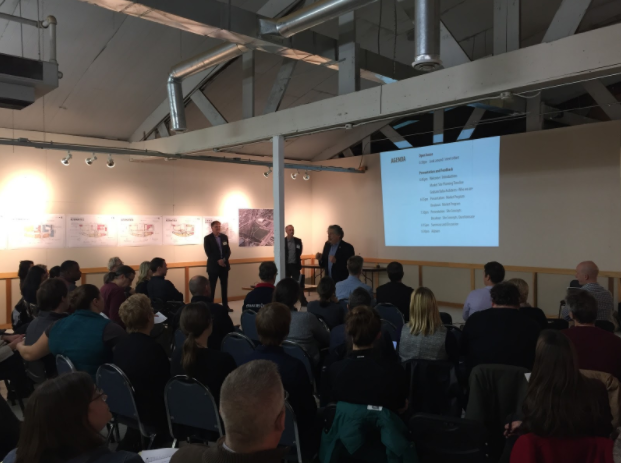






 Mayor Paul Soglin addresses the audience at the public workshop for the public market site design. (Jacy Zollar/Madison Commons)
Mayor Paul Soglin addresses the audience at the public workshop for the public market site design. (Jacy Zollar/Madison Commons)
Madison is looking to community members to weigh in on the next stages of the proposed public market on the east side.
Madison city officials held a public workshop last week to display possible market layouts and receive feedback from the public. Architecture firm Graham Baba Architects, who has created several public markets throughout the country, is heading the site design and presented potential layouts to the public.
The public market, an estimated $14 million project, would be built on First Street between East Washington Avenue and Johnson Street. The site design has been in the works for about four years and aims to bring together local food retail, farmers, wholesaling and arts while offering the public an affordable and lively place to spend time.
Many attending community members questioned the market’s accessibility, affordability and funding.
"When I hear that it's going to be a $14 million, brand shiny new thing and it looks like the new site will be reconfigured and redesigned, I think we have other things in the city we can spend money on,” said Cathy Debevec, Madison resident.
A majority of Madison’s alders are enthusiastic about the project and what they think it will add to the city.
“We love the idea of being able to have a public space that people can mix and mingle and meet that doesn’t necessarily require us to go downtown, go through campus, pay for parking,” said Amanda Hall, alder for District 3 in Madison. “We’re looking for a place that will be in many ways another Union Terrace.”
Mayor Paul Soglin proposed a control structure similar to the Monona Terrace’s where a non-profit is responsible for the day-to-day handling of vendors and operations but still is under the city’s authority.
“The city should not be a landlord,” Soglin said. “On the other hand, we are making a considerable financial commitment here, and I do want public control in the spirit of the city.”
The project is still in its early stages of development, and the city will undergo more meetings and deliberations with public input as a central focus.
The city hopes to get the project funded and designed by mid-2017 and be open to the public in 2019.
|
|
|
Welcome to the Madison Commons, a website designed to provide news and information about all of Madison's neighborhoods and a crossroads for the discussion of community issues. The name comes from the idea of a village commons, a place for news, talk, debate, and some entertainment, too, that's open to everyone.
All rights reserved. Read more about the Madison Commons and its partners.

